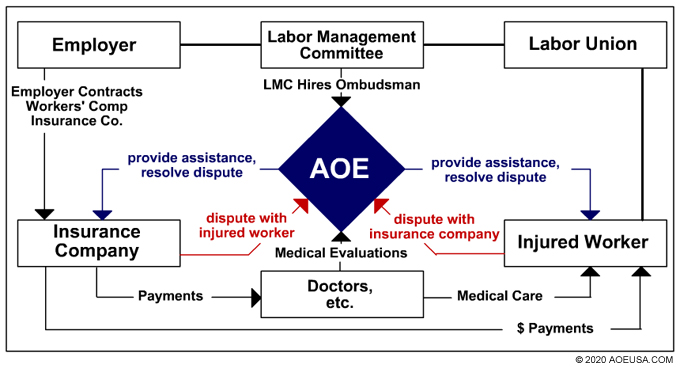Alternative Dispute Resolution (ADR) Programs include procedures for settling disputes by means other than litigation.
ADR Programs are not all the same. However, the following is a workflow illustration of a typical Workers' Compensation ADR Program administered by our organization, American Ombudsman Enterprises (AOE):

Collective Bargaining Agreement
Before an ADR Program comes into existence, an agreement must be reached between the employer and its employees that it is advantageous to participate in an ADR Program for workers' compensation. To be eligible to participate in a Workers' Compensation ADR program, the employer(s) must be either a trade association, a group of employers, a project with several employers or a single large employer of sufficient size. The employees of the eligible employer(s) must be an organized labor union. The employer and employee organizations must reach an agreement in principle that the ADR Program serves both interests.
ADR Program Setup
After a collectively bargained agreement providing for the ADR Program has been established, a Labor Management Committee (LMC) of some type is formed. The Committee is normally composed of an equal number of appointees from management and labor. In general, this Committee is responsible for overseeing the ADR Program. Among other things, the Committee approves the lists of doctors and other vendors which can provide services to injured workers. The Committee also approves the selection of the ombudsman, mediators, and arbitrators.
The Injured Worker
The injured worker receives medical care and in addition, cash payments during the healing period and cash payments that are agreed upon in the final claim settlement. It is the goal of the LMC that the injured worker is treated fairly and that given the circumstances of the injury, the best possible outcome ensues. The Ombudsman is available to answer questions and help inform the injured worker about the workers' compensation claims process.
The Ombudsman
The Ombudsman is responsible for operating the ADR Program. Once an injury occurs, and an injured worker files a claim, the alternative dispute resolution system begins to work toward an expeditious and equitable result for the injured worker and the insurance company. The expertise provided by the Ombudsman ensures that the claim submitted by an injured worker continues heading toward the swiftest and most equitable resolution possible. The Ombudsman plays an active role in accelerating the claims process and answering any questions from the parties in interest. Our proprietary systems and the expertise of our staff -- made possible by years of experience in the workers' compensation arena -- save people time and money.
Medical Practitioners
Medical practitioners, including doctors and qualified medical evaluators, are all approved by the LMC and provide medical services to injured workers involved in the ADR Program. They provide medical reports and evaluations to the parties and are compensated by the insurance company that provides workers' compensation insurance coverage for the employer. The determinations of the medical practitioners play the most important role in determining the nature of the claim settlement.
The Insurance Company
The Insurance Company receives money from the employer in exchange for providing workers' compensation insurance coverage. The insurance company is therefore responsible for paying for medical services relating to an employee's qualifying injury. The insurance company will also make direct cash payments to the injured worker arising from the result of lost wages or lost function that are included in the final settlement of the claim.

